Is Graffiti a Barometer for Freedom?
Reflecting on L.A.'s Oceanside Plaza graffiti towers, an encounter with the WaterMonster, and spring and summer classes.
Last week I visited Los Angeles for the AWP conference, an annual gathering of writers, editors, writing teachers, college and community writing programs, and publishers that drew over 10,000 attendees. Every person I talked to at the conference felt vulnerable, their livelihoods and vocations dependent on support from the National Endowment for the Arts, the National Endowment for the Humanities, educational institutions, and libraries, all of which are under siege, not to mention the looming threats of book bans and tariffs. But just across the street from the Los Angeles Convention Center where AWP took place, a renegade collective community art project loomed that I believe offers hope.
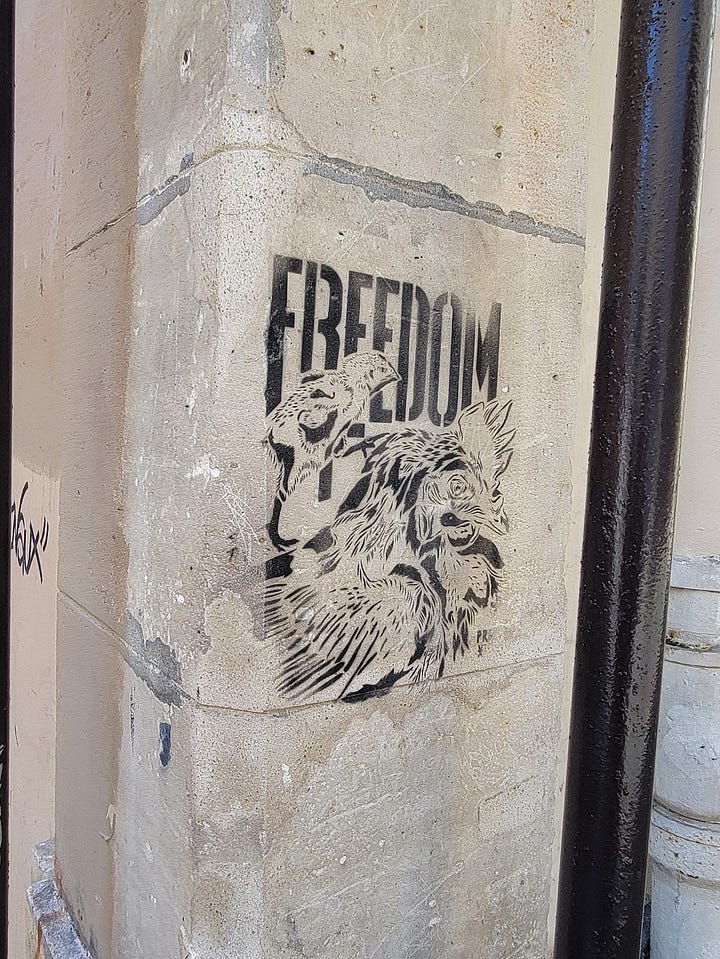
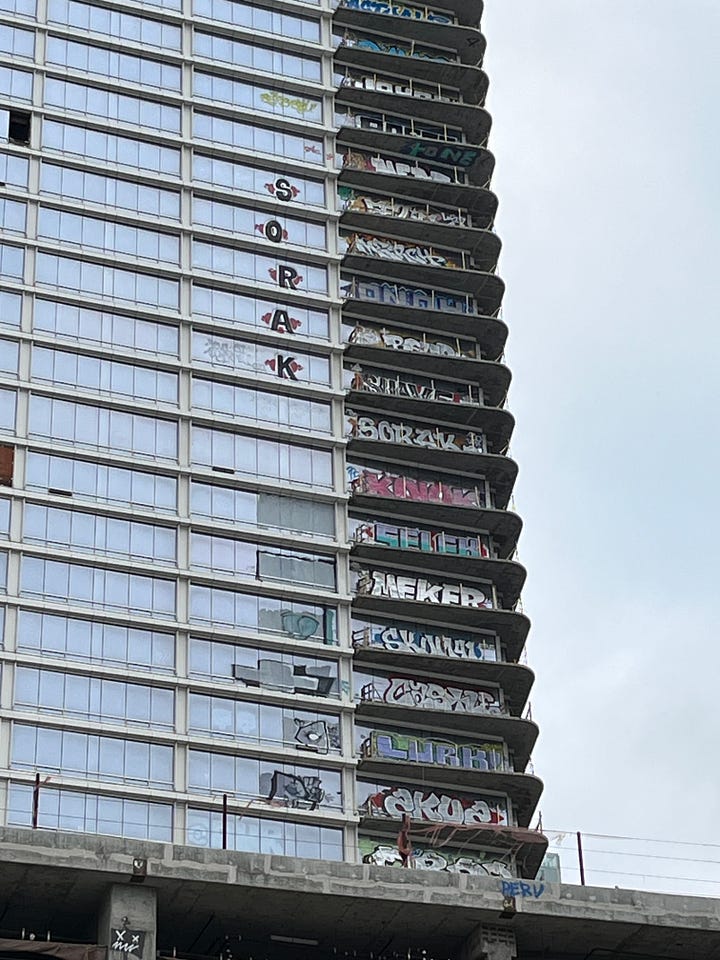
In 2015, a China-based developer began construction on the Oceanside Plaza condo towers a few blocks from the Crypto.com Arena (where the Lakers, L.A. Kings, and L.A. Sparks play). It went bankrupt in 2019, leaving the project and its three towers, two 40-floor buildings and one 49-floor skyscraper, unfinished. In December 2023, after the buildings had languished, abandoned for four years, three graffiti artists, Akua, Sour, and Castle, realized that no one was guarding this enormous canvas and they broke into the complex and painted murals of their tags on the floor-to-ceiling windows. The windows appear to be around the same classic dimensions of New York City subway car burners that graffiti forebears began painting in the 1970s. Last year, artists thronged to downtown L.A. to add their own burners to the high rises, with the developers leaving them undefended. As the New York Times put it, “Skyscrapers in the heart of Los Angeles were a financial failure that many people had ignored — until graffiti artists tagged their windows.”
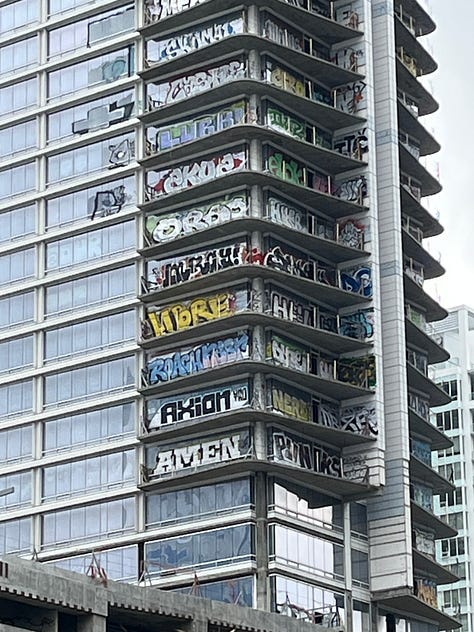


The art attack was too massive for police to contain, and when I saw it two weeks ago, almost every window on the corners of the three buildings remained adorned. Like sidewalk dandelions, graffiti writers are diligent about finding the cracks in the system where they can flourish. The original graffiti writers established a code, denoting where it was acceptable to paint and where it wasn’t, preferring to leave natural and beautiful surfaces, as well as people’s private homes, alone. Ugly and neglected walls were fair game. A billion-dollar corporate failure in the middle of the most trafficked area of Los Angeles was the biggest green light possible.
Everywhere I travel, I read the walls and try to interpret what the artists are saying. I’ve come to see the presence of street art as a barometer of freedom. All healthy democracies have graffiti. If it’s present, it means the local artists enjoy enough personal freedom to express themselves and hone their creativity, and they feel bold enough to try because they figure any punishment they might face will be survivable. A city with no graffiti means the residents live in so much terror and restriction that their creativity is squelched along with their freedom. Indeed, many Syrians believe that their country’s civil war was sparked in part by the arrest and torture of 15 teenage boys for spray painting a high school wall in 2011.
There are limits to this idea that graffiti might indicate freedom. Citizens don’t feel safe when there is too much graffiti, covering every urban surface. Too much graffiti is a sign that lawlessness has gotten out of hand, that no one fears being caught for any transgression. When looking at graffiti to measure the creative health of a city and its citizens, it’s a “too hot, too cold, just right,” barometer.
A few years ago while in France, I took a bus from Aix-en-Province to Marseille. A moderate amount of graffiti decorated the highway in Aix, but as we approached Marseille, the graffiti proliferated, with tags all over the highway and into the streets and subways, suggesting nobody feared punishment in Marseille. Indeed, this crime comparison between the two cities reflects this difference. Aix’s smattering of street art indicates it has the right balance of freedom and security for art to flourish, as it does throughout its galleries and music and theater festivals.
I took a graffiti tour of the Montmartre neighborhood in Paris, famous for the Sacré-Coeur, the Moulin Rouge, and for its artists, from Van Gogh to Picasso to Renoir to the street artists of the present day. My guide, an artist herself, led us toward street art of astonishing variety: murals, stencils, mosaics, stickers, a tiny music box installed behind a street sign you could crank to play if you knew where it was hidden, a sculpture of two bronze stick figures, reading, bolted to a railing.
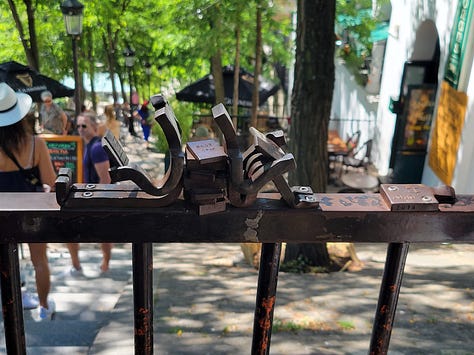
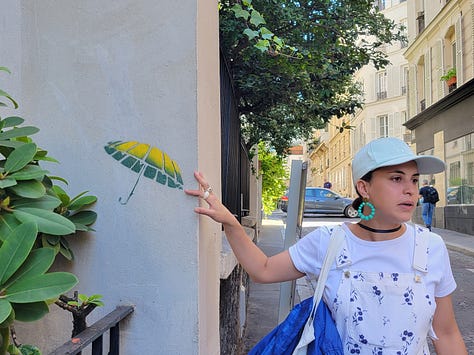
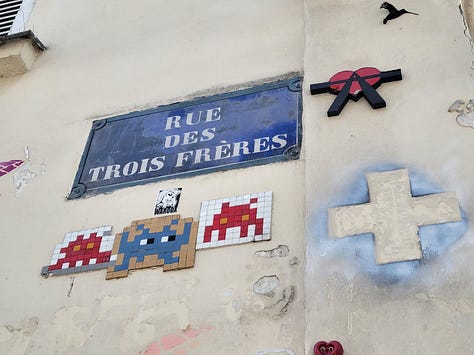
The guide explained that the street cleaners of Montmartre serve as curators, deciding which of the art should endure, and which should be buffed away. She pointed out a piece by a pioneering female artist, Miss.Tic, who stenciled images of beautiful babes with saucy slogans across the city. She’d just died that year, and the community preserved her surviving murals. What’s more, her art continued to inspire young artists, with another woman stenciling under the nom de paint Mass.Toc, a play on Miss.Tic’s name, leaving her images of babes that were more robust and ethnically diverse than the ones Miss.Tic created.

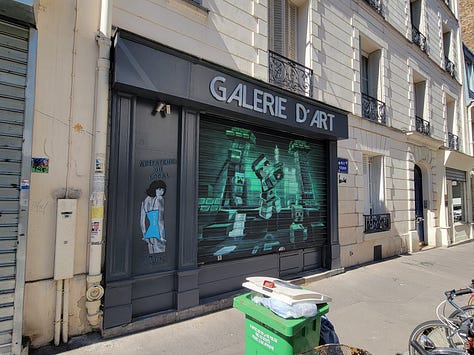

It all reinforces my theory—if there’s no graffiti in a city, people don’t feel free, safe, or inspired. If there’s a reasonable amount, the people and their creativity is healthy. If there’s too much, lawlessness has gotten to a point where other citizens might not feel safe. It’s a continuum. But, all things considered, I’d rather live in a place with too much freedom than too little.
About twenty years ago I visited China for my cousin’s marriage to the daughter of the Chief of Security of Sichuan province. We were feted and ferried around, riding in a flower-bedecked Mercedes to the wedding. We visited tourist attractions with the bride’s family, and some of the younger people spoke English. At the time, I worked at The Onion, but when I chatted with a friendly young woman named Hima, I could not explain to her in a way that she could understand what The Onion was, or what political satire was. It was not allowed in China, which perhaps explains why a Chinese newspaper once reprinted an Onion article—about the U.S. Congress demanding a retractable dome for the Capitol—as fact.
Somehow, the bride’s father found out I was “a journalist.” I was asked to refrain from writing anything about the trip. I agreed, out of respect to the family, even though this chafed me. But, that marriage has ended, and I want to tell the story, because it illustrates my continued hope for our country during this grim moment of curtailed freedoms and relentless attacks on the arts and humanities.
My hope is that a country where The Onion can flourish, a country full of street art, a country where we have relished making fun of the asses that govern us for hundreds of years, is perhaps not easily quashed. As long as all of us hold the line, together. A country where a massive community art project arises when three nervy artists figure out that no one’s going to stop them like it did in Los Angeles is a country I still have hope for.
When you look to the streets, take courage in every offering of art you find, and welcome it as a sign of the continued presence of Americans who have never agreed to obey unearned authority.
The Assorted Whimsy Portion of The Tumbleweed
On Saturday I went to my son’s track meet on a blazing 80-degree day in Longmont, Colorado. Just across from the track, I found the WaterMonster:


It was the largest water cooler I’d ever seen, with eight spigots arrayed around its bulk. However, I didn’t see any athletes refilling their bottles from the Monster. Perhaps they were put off by its vaguely ominous admonition, “Hydrate Responsibly.”
The Book Recommendation Portion of The Tumbleweed
For The Emancipator, I reviewed Jennifer Neal’s hybrid memoir My Pisces Heart: A Black Immigrant’s Search for Home Across Four Continents. I wrote:
In the bracing and insightful memoir My Pisces Heart: A Black Immigrant’s Search for Home Across Four Continents, Neal recounts her adult life abroad, as she moves between Japan, Australia, and Germany. Her American “Blaxit” was hastened by the racism she directly experienced and observed more broadly, a desire for adventure, and familial estrangement that grew more pronounced the longer she lived overseas. “My Pisces Heart” is a travel memoir that steers clear of the glorification of exotic climes trope and, instead, interweaves personal stories, observations, and research on how her chosen countries have historically treated Black people.
The Happenings & Links Portion of The Tumbleweed
I’m teaching a 4-week class for Lighthouse Writers Workshop this spring, Seeing the Big Picture: Techniques for Revising Fiction and Nonfiction Books, on Tuesdays, April 29-May 20 (6:30-8:30 p.m. MDT). You can join via Zoom or in person at 3844 York Street in Denver. My goal with this class is to teach you how to edit your own manuscript as much as you possibly can before you hire an editor or begin to submit it for publication.
And then in June, it’s Lighthouse Writers Workshop’s big annual event, Lit Fest! Come for readings, panels, craft classes, weekend intensives and more. I’m teaching six 2-hour seminars and I’d love to see you there! (It’s $75 for members and $85 for non-members.)
Building the Writer’s Notebook, Monday, June 9, 4-6 p.m.
The Art of Literary Submission (how to submit your work to literary magazines), Tuesday, June 10, 1:30-3:30 p.m.
Beyond First and Third: Playing with Perspectives, Tuesday, June 10, 4-6 p.m.
Story as Scrapbook: Structuring Prose with Documents, Journal Entries, Letters and Articles, Wednesday, June 11, 1:30-3:30 p.m.
Freelance Writing: Getting Started and Building Your Career, Wednesday, June 11, 4-6 p.m.
How to Publish a Book (tips and ideas for all the different avenues), Friday, June 13, 1:30-3:30 p.m.
Please consider supporting Colorado Humanities, one of the thousands of arts organizations facing illegal budget cuts, with a donation or by speaking up! This organization’s wonderful programs, including the Colorado Book Awards and their support of Stories on Stage is in jeopardy.
As always, The Tumbleweed welcomes your questions and comments about writing, reading, taco eating, the Denver Nuggets, rabbit wrangling, Deion Sanders, Ralphie the Bison, and baby seals.




